
Help yourself to our creative, hands-on activity ideas for teaching A Single Shard. We've been teaching children's literature in experiential ways since 2010, and we'd love to help you engage and inspire YOUR kids!
It's astounding how much they'll learn while they're "just" having fun!
When kids get to do things the characters did, they GET IT. With a little guidance, they know why that experience matters. They understand its role in the story, and what secret meaning it has. They see that literature is clever and cool. They get how fun great books are—and they want to read more.
Read on for:
Creative Teaching Ideas
Prep Tips & Printables Set
FAQ & Support
Learning Links
Our activity ideas are perfect for homeschoolers, co-ops, classrooms, libraries, book clubs, and families.
for use with some of the activity ideas on this page
for teaching A Single Shard by Linda Sue Park
LitWits makes a small commission (at no extra cost to you) on supplies or books you buy through our Amazon affiliate links.
Creative Teaching Idea #1
A table of objects pulled “straight from the story” can lead to all sorts of wonderful discussions and wide-eyed, “aha!” moments. Throughout your teaching experience of A Single Shard, pause to discuss and/or pass around relevant props. Items unique to the setting help kids understand “what that was like,” and those symbolic of themes help kids literally grasp big ideas.
Creative Teaching Idea #2
We think it's important to know where your books have come from. After all, without Linda Sue Park, we wouldn't have the wonderful story of A Single Shard. This activity introduces your kids to the author through her website and a short, kid-friendly video biography, and lets them practice some note-taking, too.
Photo of Linda Sue Park, with permission from lindasuepark.com/biography
Start your experience of this story by introducing the kids to Linda Sue Park, so kids can see the connections between her lived story and her written story. The biography on her website includes some "fast facts" and lists, including former jobs, favorite libraries and teachers, and pets—with photos.
(If you'd like a worksheet for author note-taking and conversation-starting, there's one in our printables set.)
Then share the video below, in which the author tells how A Single Shard came about, and ask the kids what they might like to research and write about someday.
For further information
We encourage you to read through the interviews and biographical articles about Linda Sue Park in our Learning Links at the bottom of this page.
Creative Teaching Idea #3
Chapters 1-12
A Single Shard is about a journey toward a dream, layered with a journey toward a real place in medieval northern Korea. In this activity, kids trace Tree-ear's walk from his village of Chu'ulpo (in Puan, today's Buan County) to the palace in Songdo, now called Kaesong, and learn why it's off limits today.
SUPPLIES
a globe (or Google Earth)
a printed map of Korea, or the geography worksheet in our printables set
DIRECTIONS
You can track Tree-ear's journey all at once, or in steps as you do the activities in story order.
On a paper map (or our interactive geography worksheet:
Find and circle the village where the story begins. In the Author's Note we're told that Ch'ulp'o was located in Puan, which is now called Buan County, about 20 miles south of Gunsan on the western coast.
Find and circle Songdo, now called Kaesong, in the north. (The palace is now an archaeological site.)
Find Boryeong and Daejon; between them is the general location of Puya, where Tree-ear stops to climb the Rock of Falling Flowers (now Nakhwaam, or Nakhwaam Rock). Draw a flower in this area.
Circle South Korea's capital city of Seoul, which Tree-ear sees as a beautiful valley.
Draw a line to show Tree-ear's travels between Buan (or nearby Gunsan) and Kaesong, being sure to go through Puya and Seoul.
Now use the globe or Google to "zoom out" and show Korea within Asia, and Asia in the larger world, in relation to your own location.
Explain that today, North and South Korea are divided into two, roughly along the 38th parallel. This was the dividing line in 1945; in 1953 it was redrawn and named the De-Militarized Zone, or DMZ. You might want to share some child-level facts about the DMZ.
Tree-ear's journey took him across this important geo-political border, which would not be possible today.
LitWits makes a small commission on supplies or books you buy through our Amazon affiliate links.
Creative Teaching Idea #4
Chapter 3
In the beginning of A Single Shard, Crane-man does all the cooking, such as it was: “It seemed to Tree-ear that his friend spent the entire day figuring out how to transform a handful of weeds and bones into something that resembled a meal.” In this activity, kids get a story snack that might be unusual to them—okay, not weeds and bones, but it's fun to let them think that.
SETUP
Remind the kids that the point of the snack is to serve a unique food that's meaningful to the story. A Single Shard opens with a scene of hunger, and we later learn that Crane-man often "spent the entire day figuring out how to transform a handful of weeds and bones into something resembled a meal."
Now tell the kids something like, "That reminds me, it's time for a taste of the story!" and lift a corner of a dishtowel to reveal some weeds.
They'll be disconcerted, at the least. Tease them along from there, sort of like this, only feel free to improve on our puns:
"Just kidding—I couldn't find bones to flesh out this snack, and weeds seemed kind of dry, so I went with something else unique. Remember when Tree-ear picks fungus and fern leaves to eat on the job? Well..."
Play this out as long as you can, talking about your low budget and how resourceful Tree-ear was to make do with nature. By now the kids might be on to you, but in our experience, they'll go along for fun.
"Just kidding! I had to go with something I knew wasn't poisonous. Remember when Tree-ear finds a cabbage core at the dump to contribute to Crane-man’s dinner recipe?"
This one's plausible, so you'll have to really work it, emphasizing how nutritious cabbage is, and that you got yours at the store for Pete's sake, not the dump. Maybe pull a cabbage core from a grocery bag.
"Just kidding! Remember when Tree-ear's hard work and ethics earn the respect of Min's wife, and she feeds him?"
Enjoy watching their faces brighten up with relief as you read the Inspiration below.
INSPIRATION
Tree-ear sat on a stone under the paulownia tree and untied the corners of the cloth. It held a gourd bowl filled with rice, whose whiteness was accented by a few shreds of savory dried fish and a little pile of kimchee—pickled cabbage vivid with seasonings of red pepper, green onions, and garlic. A pair of chopsticks was laid neatly across the bowl.
Tree-ear picked up the chopsticks and stared for a moment. Of one thing he was certain: The feast-day banquets in the palace of the king could never better the modest meal before him, for he had earned it.
—Ch. 3
Tell the kids that Ajima's in town and has been cooking all morning! Have them line up at her/your kitchen for the Modest Meal before them . . . for they have earned it. Then reveal the real snack.
While they're eating, cover talking points like those below.
TALKING POINTS
A reward is so much better when earned—not a gift, or worse, a theft.
How does Tree-ear show his gratitude to Ajima?
When Tree-ear earns the farmer’s permission to pick up the fallen rice, we see the boy's character right up front. From now on we know to expect honesty from him.
And when he's able to share Ajima's generosity with Crane-man, we see how good it makes him feel to give.
Was it wrong to share food meant for someone else?
This is an important moment for Tree-ear, because now he’s gone from a dependent beggar to a working provider. He’s not an unskilled kid any more; he’s a young man with a trade. It’s time for him to give back to the man who’s cared for him 10 of his 12 years.
Why would Crane-man not have approved of Tree-ear leaving an empty bowl for Ajima to fill?
SUPPLIES & PREP
The list below is for supplies to wrap up the snack for each child, to resemble Tree-ear's cloth-tied lunch. Use a napkin and raffia to wrap a precooked rice bowl and a packet of kimchee, and top it with chopsticks.*

For each child:
chopsticks (here's a simple how-to-use video)
holepunched tag indicating the meal is from "Ajima's Kitchen" (make your own or use the one in our printables set)
Cover up the rice and kimchi with a scarf (or any fabric) until you're ready to reveal it.
If you want to tease your kids as described above, you'll also need a dishtowel and a few weeds. You might want to have a fern frond and a cabbage core on hand too.
*Alternative presentation: cook rice in the classroom and serve it hot in small wooden bowls, or paper versions, with kimchee, or cook it ahead and serve it cold (as it was for Tree-ear).
LitWits makes a small commission on supplies or books you buy through our Amazon affiliate links.
Creative Teaching Idea #5
In literature (and life), there’s always a reason why people do what they do and are the way they are. A good author lets us figure that out by watching how her characters act. In this creative writing activity, kids learn the writing skill of "showing" through action, instead of "telling" through narration.
SETUP
Tree-ear’s story is told from his point of view, so we always know what he’s thinking and feeling. It’s sort of like the author is inside his head with him. But what about the other characters? How do we know what Min, or Crane-man, or the Royal Emissary, or anyone else might be thinking or feeling?
We know because Linda Sue Park does a beautiful job of describing behavior that shows us, instead of telling us. For instance, she could have written “Min was too gruff to say it, but he had affection for Tree-ear and would miss him while he was gone.” Instead, she describes how Min puts his hand on the Tree-ear’s shoulder, then turns away without saying good-bye.
"Showing" helps us understand the character of a character too. What do we know about Min in that moment, without being told outright?
Now it’s your turn to show how someone is feeling.
DIRECTIONS
Give the kids a prompt that has no emotion in it, and have ask them to write a scene describing what happens next, showing the emotions without actually naming the feelings. (Or use the creative writing worksheet in our printables set.)
For instance:
Miguel looked up from his desk and saw the teacher standing beside him, holding a clipboard.
Sample response: His heart started to hammer inside his chest and his face got hot. Had she seen him? He slipped his left hand under the desk and wiped it back and forth on his jeans as hard as he could, trying to scrub off the formula.
After the kids write, invite them to read aloud, and talk about what's revealed. For instance, using the sample above:
Feelings: scared, nervous, anxious, embarrassed, desperate
Character revealed: he may have been cheating on a test, but his anxiety about it makes it seem as if he doesn't do it very often
What the reader might think and feel:
why did he cheat?
was he under pressure from someone else, or is he hard on himself?
I know how that feels . . .
do I feel sorry for him? why or why not?
what do I want to happen next?
If the prompt had been "Miguel was nervous because the teacher probably had caught him cheating," we'd miss out on all that figuring-out— and our own feelings, too.
LitWits makes a small commission on supplies or books you buy through our Amazon affiliate links.
Creative Teaching Idea #6
Chapter 6-7
Even though Tree-ear isn’t allowed near the wheel yet, he keeps working hard (for free!) and dreaming of designing a prunus vase to hold a single branch of flowering plum. In this activity, kids get to fulfill his dream, while learning about the art of Korean celadon pottery.
It's fun to try a little bit of Min’s art by pursuing that elusive celadon color, coming up with a design, and then inscribing it on a vase, revealing the darker color underneath.
The finished project can be glued to a "pedestal" for museum display. The templates for the vase and display are included in our printables set.
SETUP
First, have the kids watch this master Korean potter at work, like Tree-ear did from behind the Pawlonia tree:
Then show this video of Korean master potter Kim discussing celadon pottery:
Next, show images of real 12th and 13th century Korean celadon pottery. and share a little about its history and how special it is,
Now tell the kids that a royal emissary is on his way to grant a commission, and all potters are invited (expected!) to produce their best work. Their first challenge is to come up with the perfect shade of celadon; their next is to design a prunus vase.
SUPPLIES
containers for paint (for individual students, if not sharing)
cups of water for rinsing brushes
paper plates for mixing paint
templates for vase and mounting block and museum label (in our printables set) to be printed on white cardstock
black cardstock for background
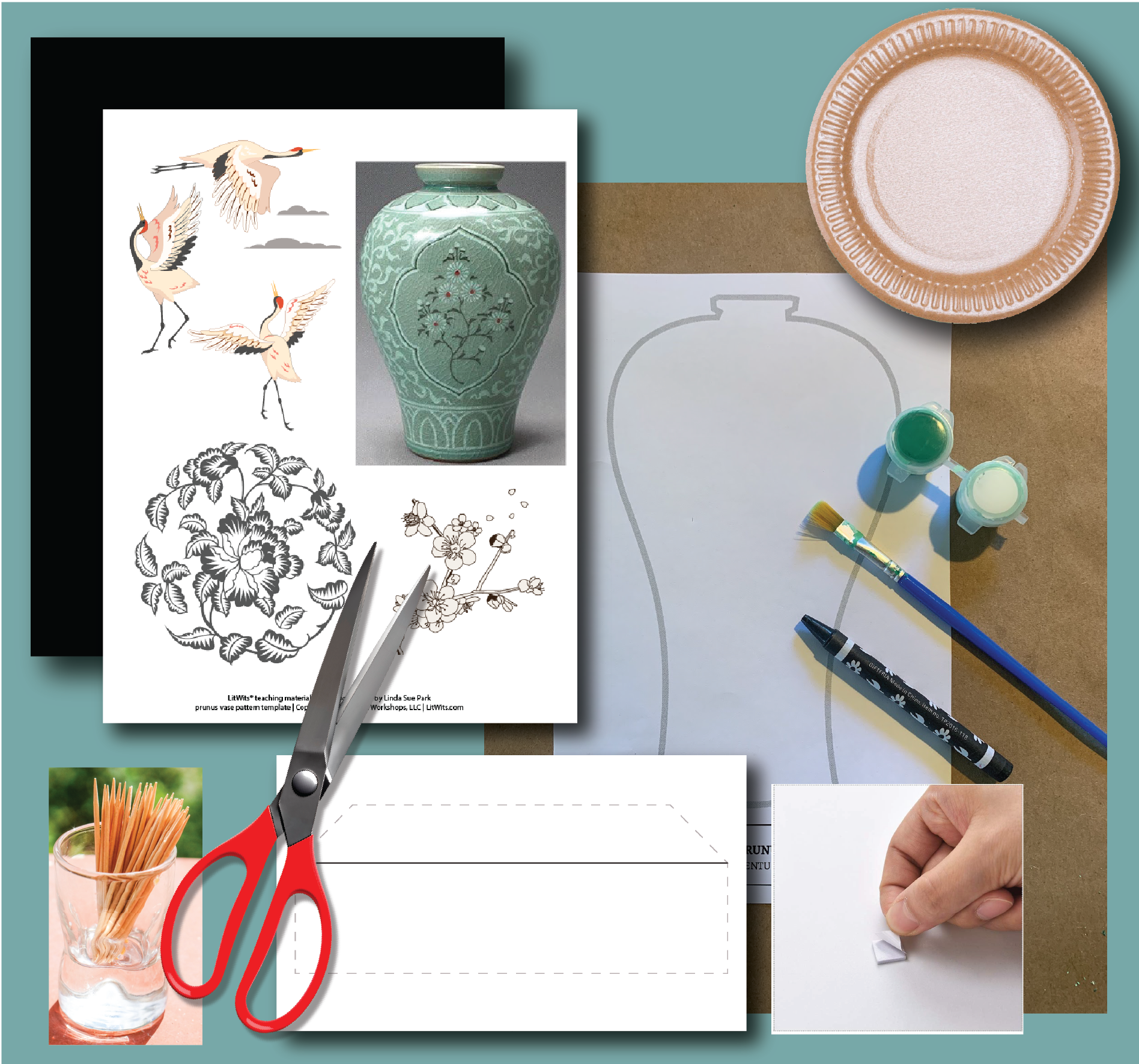
DIRECTIONS
Tell the kids:
Mix green and white paint together on a paper plate until you're happy with your celadon shade. Remember celadon is not one perfect color. but an "indescribable" and "mysterious" wide range of greens, so relax and have fun..
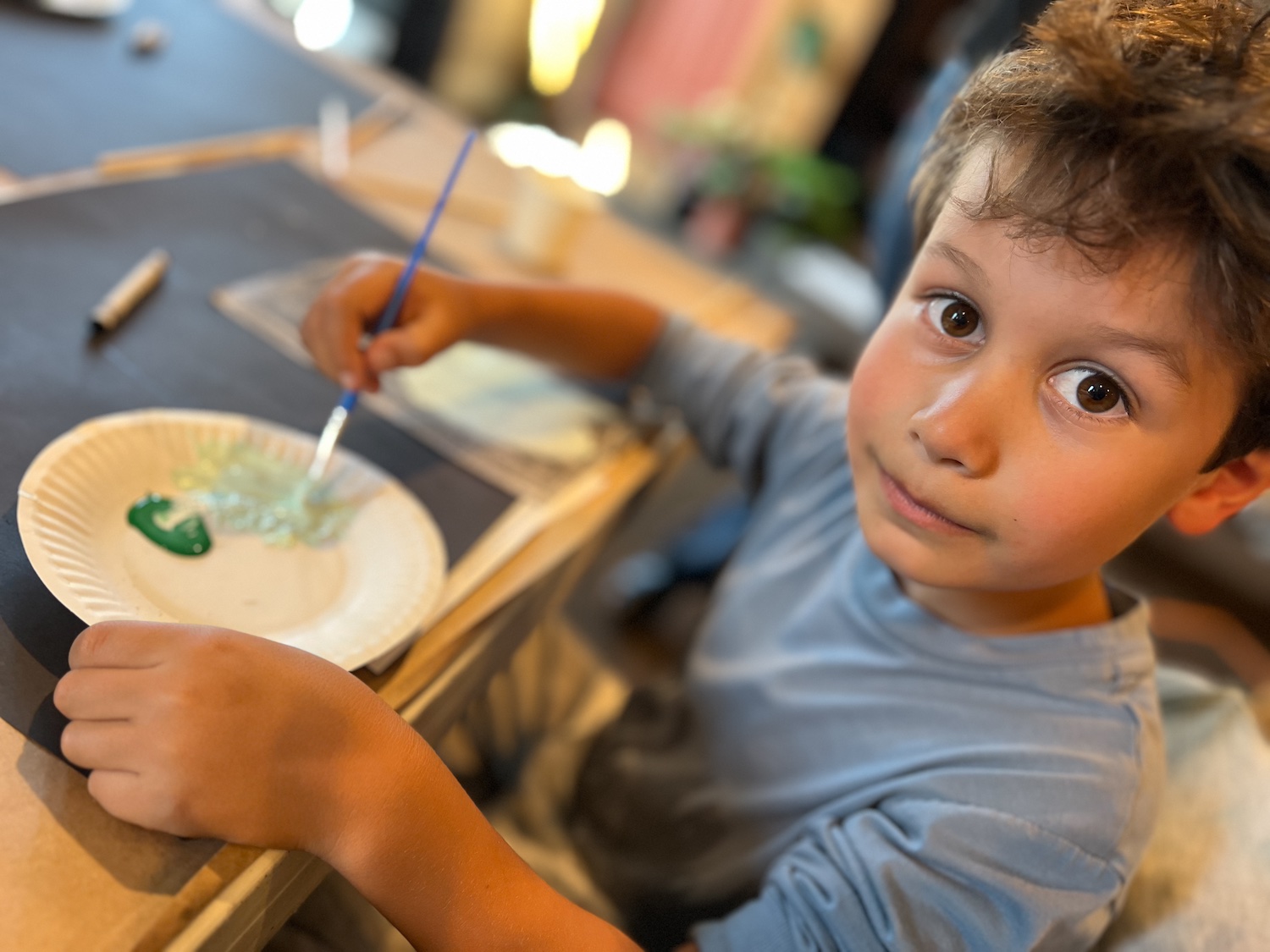
Color the back of your prunus vase with black crayon, heavily, to about an inch (or less) from the edge of the paper.

Paint over the crayon using long, steady strokes, not short dabs. Don't leave puddles or ridges that will take a long time to dry.
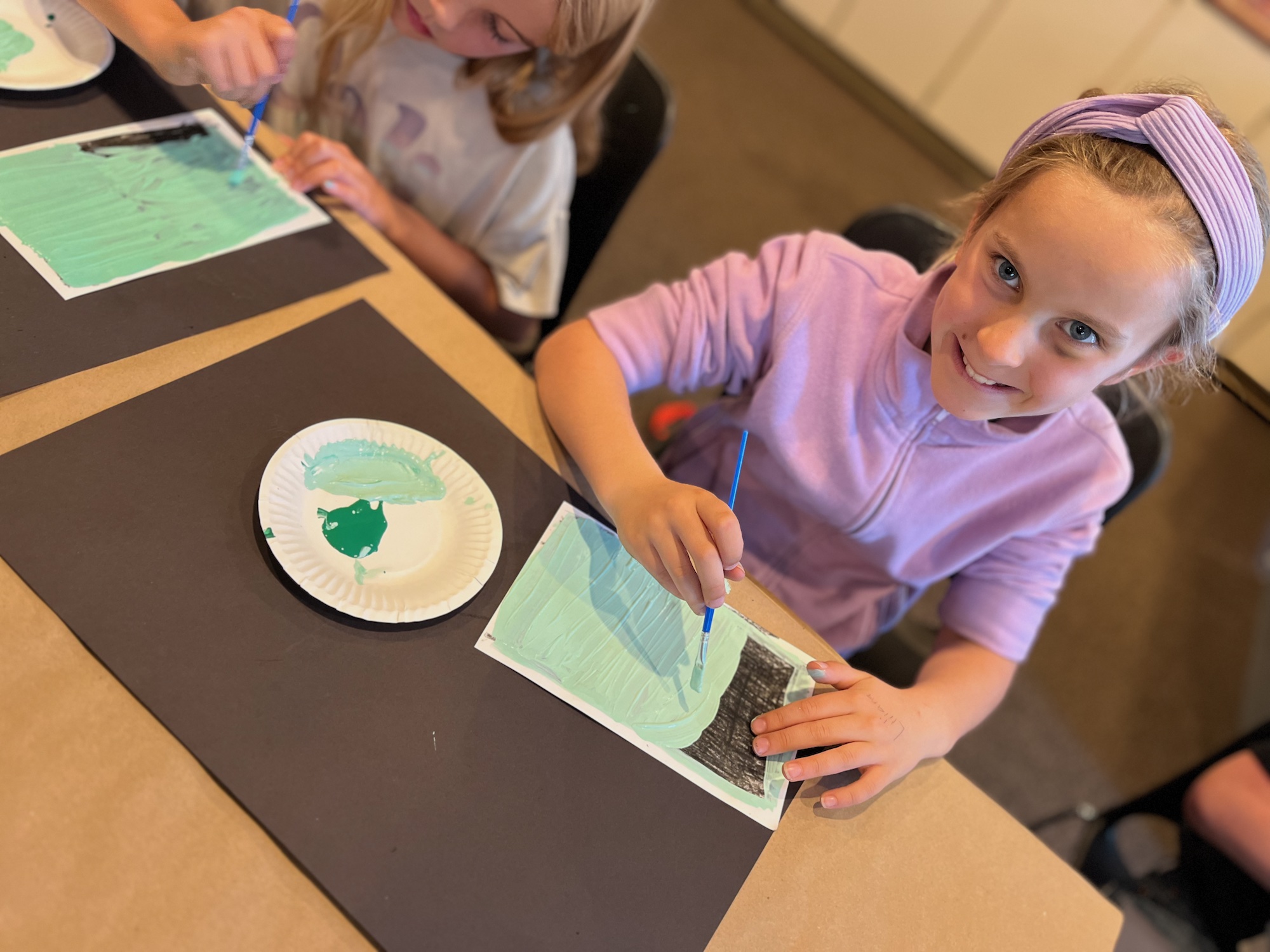
When you're finished, close up the leftover paint. While the paint is drying, watch this inspiring video of a master Korean potter inscribing patterns on pottery:
[Cover some talking points, below, while continuing to allow the paint to dry.]
When the paint is dry, cut out the vase. then use a toothpick to inscribe a design of your own.
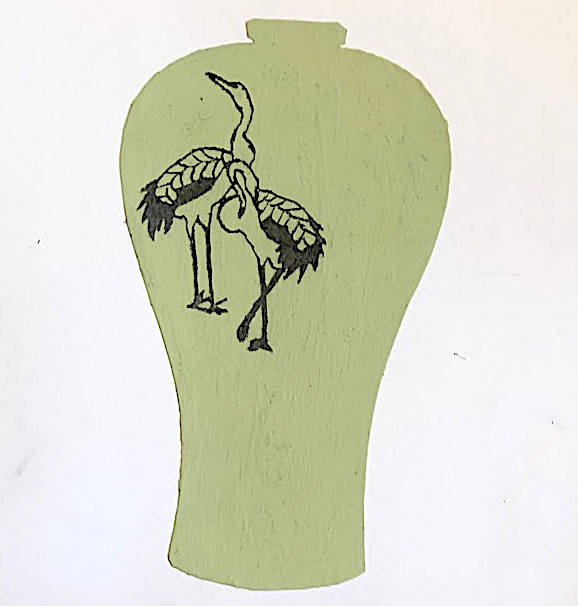
Our printables set includes images to use as inspiration or to trace using the transfer method. (Images may vary from those shown here).
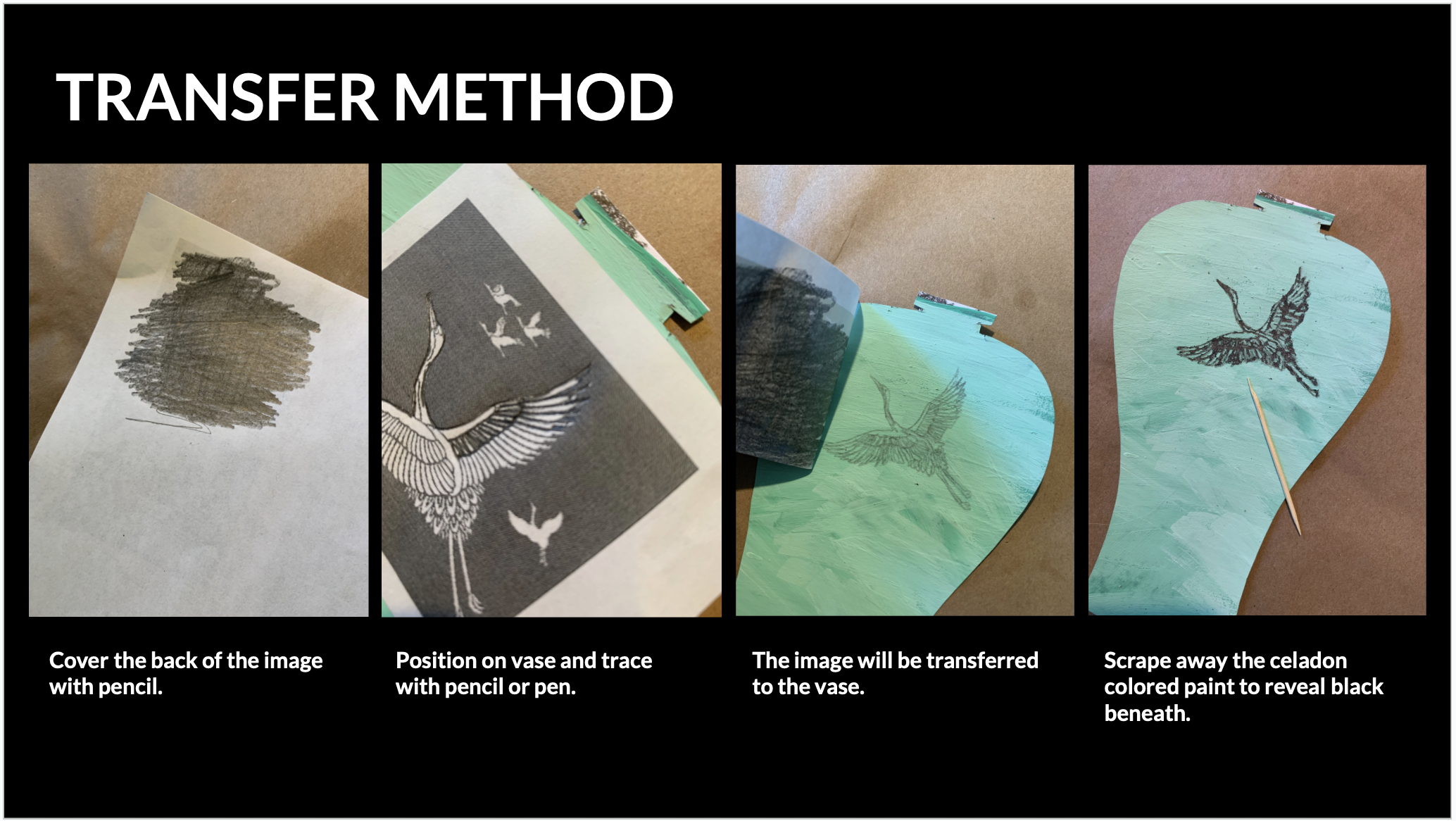
Cut out the pedestal and glue it to the black cardstock, about a half-inch from the bottom edge. Then cut out the label and glue it to the pedestal.

Finally, use pop-up tabs to mount the vase to the pedestal, like this:
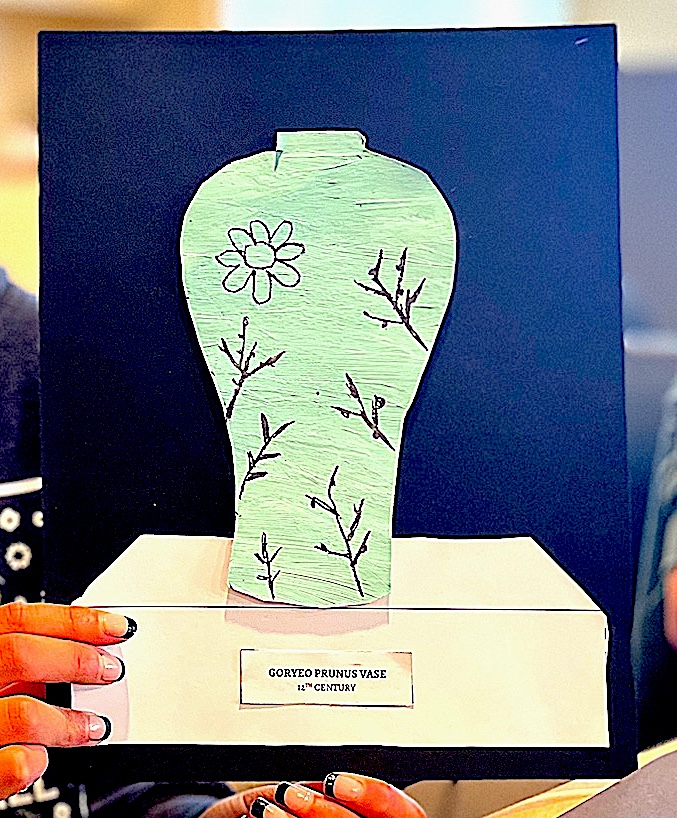
TALKING POINT: Intellectual Property
Tree-ear asks Crane-man if it's stealing to take another’s idea.
What was Crane-man's answer? [Crane-man's answer is that if the idea has been told, it belongs to everyone; if it’s a secret taken by stealth or trickery, that would be stealing.]
Why doesn't Tree-ear tell Min about Kang's inlay technique right away?[Tree-Ear had become aware of it by stealth, so he waits until Kang's new technique is displayed for the emissary.]
This is a question just as important today, about anything created by the mind—it's the basis of modern intellectual property law.
There are four main types of protected creations: one is trade secrets, like Kang's.
Can you think of three other types? [inventions (protected by patents); original written works (protected by copyrights); brand names and logos (protected by trademarks)]
When can you use someone else's work without permission or purchase? [when it's in the public domain]
If you'd like to take this important topic further, The World Intellectual Property Organization has online resources for teachers, and an interactive "IP Challenge" on their Respect for Intellectual Property site.
LitWits makes a small commission on supplies or books you buy through our Amazon affiliate links.
Creative Teaching Idea #7
Linda Sue Park grew up speaking English, and knew only three Korean phrases. In this activity, kids get to learn those phrases and their meanings, along with others in A Single Shard, and write a scene in a creative mash-up of both languages.
There's no better way to learn a language than to use it!
DIRECTIONS
Choose several Korean phrases from Linda Sue Park's introduction and story. (There are seven on the creative writing worksheet in our printables set.)
Talk about their definitions, as given in the book.
Have the kids write at least one paragraph using a blend of those phrases and English words.
The paragraph of "Korlish" can be about anything, but you might encourage the kids to write a scene from a story—not necessarily with a beginning and end.
You can imagine the fun to be had, for instance, with these three phrases:
pyunsul odisoyo (where is the bathroom?)
toduk-nom (bandits)
gokkam (sweet dried persimmons)
LitWits makes a small commission on supplies or books you buy through our Amazon affiliate links.
Creative Teaching Idea #8
Chapter 9
Tree-ear is crushed when Min refuses to take him on as an apprentice, but he realizes he still has skills, and molds himself a monkey that turns out to be a key to Tree-ear's future. In this activity, kids get to "do what Tree-ear did"—but with a lot fewer blisters.
After reading all the descriptions of potters at the wheel, kids really do identify with Tree-ear’s desire to get his hands on the pottery-making process. But providing a wheel and clay for your kids isn't likely to be practical.
Fortunately, when Tree-ear decides to begin molding clay with his fingers, we've got a fun, simple, doable, enjoyable project to imitate! Molding a monkey is something your kids can really get their hands on and put their hearts into.
And of course, the monkey Tree-ear made for Crane-man turns out to be central to the story, and present in the beautiful, bittersweet resolution.
DIRECTIONS
While talking about how Tree-ear kept a ball of clay with him abd eventually made it into a monkey, pass out balls of clay to the kids. They'll catch on pretty fast and be delighted at the prospect of "doing what Tree-ear did."
Provide a monkey model and pictures of Korean celadon monkeys from the Goryeo period, like this one and this one.
Body: Start with an oblong shape and mold a head and torso and arms and legs from it—this makes their figures as solid as possible, without spindly arms and legs and tails that might break off during the baking or painting process. (If the kids do make separate limbs or heads and then attach them, have them blend pieces together well so that no cracks or lines remain.)
Head: Pay attention to the outward shape of a monkey snout and the placement of ears on the sides of the head. Using a pencil to poke little endents for eyes and nostrils will create a very simian effect.
Details: For kids with more detailed artistic skills, encourage them to add finer details like Tree-ear did, such as the look of fur, and differentiated fingers and toes.
Option: Using polymer clay means these monkeys can be baked and painted with a top coat of gloss that makes them look even more ceramic. It’s wonderful if you have time for all these steps, but the most important part of this activity is to make a monkey out of clay like Tree-ear did. Getting into his shoes, and in this case heart and head, is the most important part.
SUPPLIES & PREP
earthtone-colored polymer clay, such as terra-cotta. Cut into approximately 1/2 to 3/4 of an ounce per child—if you roll (or have the kids roll) each "serving" into a ball sized between a golf ball and a ping-pong ball, that will be about right. After all, the monkey Tree-ear made fit in his hand.
paper plates and napkins for workspace and cleanup
sculpting tools such as toothpicks, chopsticks, plastic knives and spoons, wooden sculpting tools, pencils, etc.
Option: acrylic paint of a celadon hue (Kids might have fun working together to mix the right color – since there are a there is a whole range of colors counted as celadon from yellow greens to gray greens, it's a fun chance to learn about color and color mixing. Any shade of light shade of yellow, blue, or gray green is fine.)
Option: Triple Thick gloss glaze to create a glossy effect once the acrylic paint has dried.
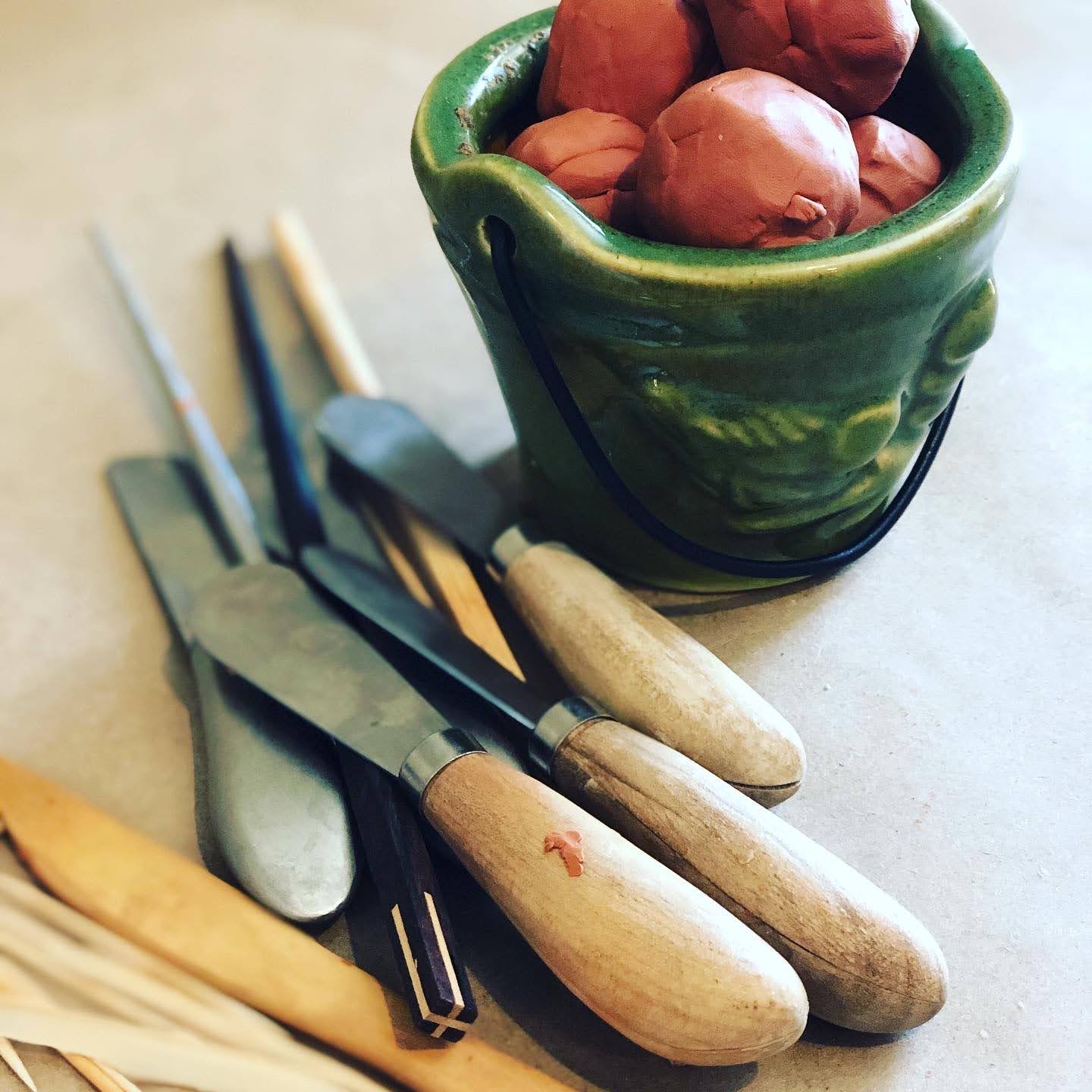
LitWits makes a small commission on supplies or books you buy through our Amazon affiliate links.
Creative Teaching Idea #9
Order, order! Without it, there's no story—just jumbled miscellaneous parts. This activity kids learn the important concept of the narrative arc (useful for all communications!), and understand how Linda Sue Park arranged A Single Shard.
You can discuss the narrative arc in any of these three ways; we've found the first to be the most engaging, because it breaks up the discussion into bite-size chunks.
Introduce the concept of the narrative arc up front, but save the story's scenes to discuss as you go, pausing to "do what the characters did" in fun hands-on ways, while weaving in discussions and other worksheets.
OR introduce the concept and complete the worksheet before the activities, so kids have a review of the story fresh in their heads first, and you can remind them "where we are" on the arc as you go.
OR at the end of your activities, introduce the concept, then help kids figure out where the different parts of this story fit on it.
The narrative arc worksheet in our printables set summarizes the story by plot point, and has kids fill in some blanks.
Creative Teaching Idea #10
We all love collecting souvenirs that remind us of remarkable places we've been. Give your kids a travel sticker commemorating their literary journey through medieval Korea, and your field trip through A Single Shard.
Give the kids the souvenir travel sticker included in our printables set, or have them design their own.
Kids might like to add their sticker to a reading kit, like an old briefcase (or faux vintage) or a suitcase that can hold a book, bookmark, glasses, snack, blanket, journal, pen, and whatever!
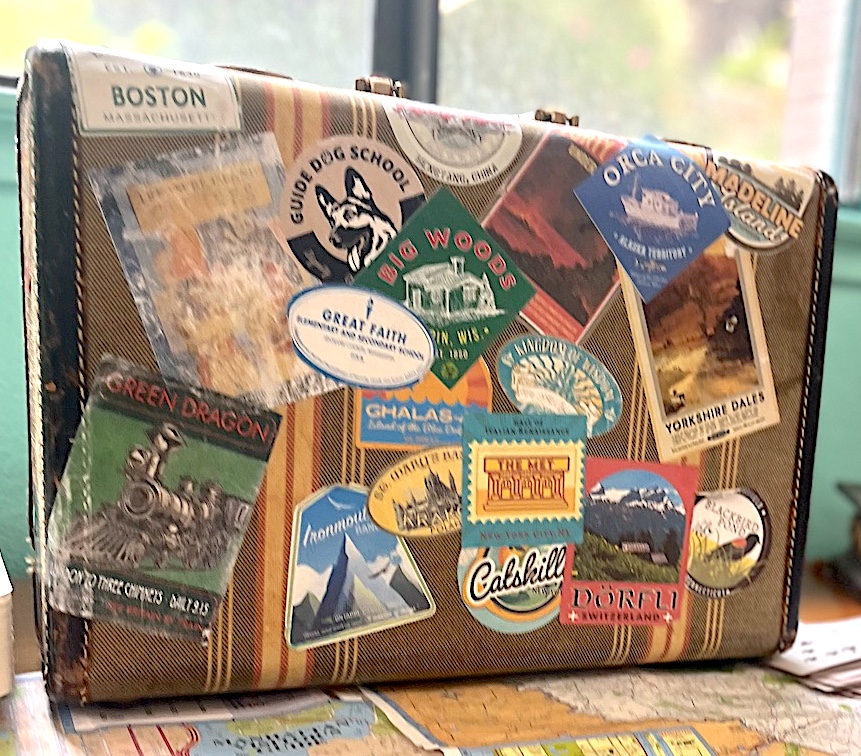
Or they might want to put it on a binder or water bottle. No matter where they see their sticker later, it will remind them of this wonderful journey they've taken with you!
LitWits makes a small commission on supplies or books you buy through our Amazon affiliate links.
Some of our activity ideas need printables or worksheets. Don't spend hours coming up with your own!
for teaching A Single Shard by Linda Sue Park
Borrow or buy the book, if you don't already have it; you can also listen to an audio version, read by Graeme Malcolm. Reading on a screen should be a last resort. The sensory feel of the pages in your hand, or the sound of someone reading to you, is the first important step in sinking into the sensory experience of this story.
This book is best for ages 9-12. (You can read reviews on Amazon). Here's our short summary of the story, which is set in medieval Korea:
Tree-ear, a poor orphan, lives with Crane-man under a bridge in the village of Ch'ulp'o. He's fascinated by the celadon ware created by master potter Min, but though he works hard at other tasks, Min bluntly refuses to teach him to be a potter. Distressed but determined to be useful, Tree-ear makes a solitary journey to present Min’s vases to the royal court—even if he has to show up with just a single shard.
Tree-ear shows us the value of diligence, humility, and respect for others, even in the face of severe circumstances.
LitWits makes a small commission on supplies or books you buy through our Amazon affiliate links.

You can have them read or listen to it on their own, or you can enjoy it together as a class. Most importantly, read only for fun! Tell the kids to simply enjoy the book, without any assignments in mind. It's hard to get caught up in a story if you're supposed to be looking for something that takes you out of it.

It's helpful to know this book's big teaching points ahead of time, and explore some fascinating links to add to your lessons. We already found those for you, so you too could enjoy reading the book without an assignment in mind. :) Our teaching ideas connect to these takeaway topics:
Diligence
Tree-ear has to work through extreme poverty to survive and difficult physical work to follow his dream of becoming a master potter. He works to the very limits of his endurance to prove to Min and himself that he has what it takes, always keeping the reward of becoming a potter in sight. Even after that dream is dashed, he puts in almost superhuman effort to accomplish his tasks. By the end, he's learned the value and gained the rewards of learning from the ground up (literally clay!), and of being willing to work very hard without giving up.
Integrity
We know from the first paragraph that Tree-ear is honest, as he won't even pick up the spilled rice without the spiller's permission. Throughout the story, we're repeatedly shown that Tree-ear has a sense of honor, not only about truth-telling but about non-stealing, whether of objects or ideas. He also works hard to do a good job even when his boss and circumstances are exceedingly unfair. Doing any job well is important to him, as symbolized in the shard he carries to prove its worth, and Min's—and his own. These are such valuable examples for readers of all ages.
Family
Not having a biological family is central to the story's conflict, as Tree-ear's status as a poor orphan gets in the way of his dream. We can't stop wondering how will he get out of this and reach his goal after all! But he does have a chosen family in Crane-man, and Min and Ajima later chose Tree-ear to be their adopted son. The story not only emphasizes the importance of family and familial support to well-being and resolution, but slowly reveals the backstory of all four in sympathetic ways that makes us want them to be together.
Additional topics
We encourage you to explore the supportive Learning Links at the end of this page, especially if you have older or more advanced kids. Make notes as you go, so you’ll remember what you want to share, and when.

Once you've read the book and have a feel for its big ideas, decide which activities to do. Don't feel you need to do them all! Choose one or two or whatever you think will best suit you and your kids. Having said that, here's a sample agenda for a 3-hour "field trip" through a great book.
This sample agenda can be followed in part or in whole, all at once or over weeks—whatever works for you.
Set the tone. Ask the kids how this book made them feel, and why, and what it made them want to do. Point out that the author intended to make readers feel, think, and act—that literature is never just entertainment.
Introduce the author. Next, introduce the author through the biography video provided, to pay tribute to the story’s creator and recognize how his/her life story shows up in the book.
Introduce the arc. Give a brief overview of the concept of the narrative arc (here's our explanation for kids). Assure the kids you'll go through it in detail together.
Find the setting. Get your bearings before you set off! Explore the setting through audiovisual aids, and talk about any setting-specific props,
GET HANDS-ON ! Do the activities you've chosen (we do them in story order, for the most part, but do whatever holds your kids' interest.) Talk about the meaning(s) embedded in each project. Pass around props at relevant points to give the kids a tactile, sensory engagement with a significant item, including food and sounds. Look for moments to pop in an audiovisual—hear that medieval chant! watch that Friesland horse run!
Worksheets: If you're using our worksheets, we suggest weaving them in between activities, to keep the writing light and energy high. This woven blend of doing, talking, and writing is what helps lessons stick, and makes this book more meaningful and memorable for your kids.
Timing: This means you're doing a new activity every 10-20 minutes, so things move quickly and the energy stays high. Of course, if your kids would benefit from a slower pace, by all means take your time. The point is to keep everyone relaxed and having fun—so they're better able to learn. Do whatever best serves your teaching needs, in the order and at the pace that keeps your kids respectfully, happily engaged.
Gather or buy your supplies. You can right-click anywhere on this page to print lists and instructions, if you'd like a hard copy—you'll need to open up the "Read more" drop-downs first.
Do the activity prep you'd rather handle yourself than have your kids do; this will depend on your time, kids' ages and abilities (and how important it is to you that the finished project looks as intended!).
Print the printables you're using, whether you made them or bought our set. Which brings us to . . .
Don't spend hours creating worksheets and printables to use with our activity ideas. We've already made those for you!
Buy our full set, for just about nothing.
Be sure to let us know how it goes! In fact, if your kids have a blast with this book, we'd love your help spreading the word about our resources for teaching children's literature.
Tag and follow us on Instagram, YouTube, Facebook, and Pinterest—and please leave a review!
for teaching A Single Shard by Linda Sue Park
Aw, you’re just the right age, whatever that might be! Just kidding—we know what you mean. We find that 8-12-year-olds are consistently “ready to LitWit.” Generally speaking, their reading level is high enough to take on the vocabulary and syntax of literature, and they’ve acquired enough knowledge to grasp new ideas. Yet they’re still full of wonder, and are highly responsive to the “check this out!” nature of sensory immersion.
However, we often have mature kids of 6-7 in our experiential workshops, and sometimes fun-loving kids of 13-14. As a teacher or parent, you know best what your kids are ready for and interested in.
Yes. Our methods and ideas are adaptable to a wide range of abilities—kids particpate at their own level. The point isn't to come up with a stellar work of art or a perfectly polished project, but to have the experience of doing something the characters did, or a spin on it. After all, those characters were of mixed abilities, too!
This is true of mixed levels of enthusiasm as well. Kids who already love reading are thrilled to get the chance to extend the story, and kids who don't yet believe that stories are fun end up wanting to read (or listen to) more great books.
LitWitting is a flexible, fun way to teach, adaptable to all ages and abilities, so there isn't "one way to do it" —every educator's circumstances and children are different. Having said that, we suggest you follow the narrative arc, and we've provided an example of a simple plan above, under Prep Tips.
But the truth is, if you and your kids are having fun, and when it's over they want more (which means reading another great book), you’re doing it right!
Absolutely—but when you're finished, they'll probably ask if there's something else you can do, or have a suggestion of their own! And that's GREAT! It shows they're liking this kind of learning, and seeing that books can be experiences for them too, not just for the people in the story.
Get your feet wet with a project you think they'll like best, never mind how deep and meaningful it is—even if they're "over" this book, if they know you'll be LitWitting other books, they'll want to read them!
In our workshops, the very most reluctant readers are the ones who, when their mom comes to pick them up, are tugging at her sleeve and saying "sign me up for the next book they're doing!" (We love that they always say "doing!").
They're right here on this page! Just click the "Read more" under each activity for all the details.
You can right-click to print this page, if you'd like a hard copy—be sure to open all the drop-downs first, so the hidden contents will print too.
We keep all this info online so we can include helpful links, make updates in real time, add new ideas, and let you use our materials on a screen.
Sure you can, for your noncommercial use in your family, classroom, library, book club, or wherever! As long as you’re not calling your fun time a “LitWits” event or charging a fee, you can use our ideas and printables to do lots of wonderful things!
Please don’t forward your printables or make copies for people who haven’t paid for them, of course, out of courtesy and to honor our copyright, and per our Terms of Service.
Did you find what you were looking for? Do you still have a question? Are you feeling inspired, but maybe also somewhat overwhelmed? Never fear—we're glad to help! You're literally on our page about inspiring kids to read more, and we'd love to support you as you change the world, one book at a time.
Happy teaching,
Becky and Jenny
Sisters, best friends, and partners
for teaching A Single Shard by Linda Sue Park
Like all children's literature, this book is chock-full of many subjects to explore. Browse these curated links to supplement your reading experience, research points of interest, and prompt tangential learning opportunities.
About the Book & Author
Linda Sue Park’s website and blog - LSP
Biography of author - LSP
Awards for A Single Shard - LSP
Video interview with author - The Kennedy Center
Interview with author about books and writing - Cynthia Leitich Smith
Reviews
Kirkus Reviews
Goodreads
Amazon
New York Times (preview or subscribe)
Literature for Kids
Everyday Reading
Beyond the Book
Respect for Intellectual Property (for kids) - WIPO
Educational resources about intellectual property rights - WIPO
"Goryeo Celadon in Japan" - scholarship in the Korean Journal of Art and Archaeology (esp. Sec. III)
"A Brief History of Korean Ceramics" - The Museum of Oriental Ceramics, Osaka, Japan
The art of Korean celadon - World History
Story Supplements
Places
Buan County (formerly Puan), where Ch'ulp'o is set per Author's Note
Nakhwa Rock - Visit Korea
Nakhwa Rock ("The Rock of Falling Flowers") - art by Kawase Hasui, 1939
Kaesong, formerly Songdo - Britannica
Songdo Palace excavation (2015)- The Guardian
Songdo Palace excavation (2025) - Korea JoonAng Daily
Nature
The mushroom for which Tree-ear is named - Missouri Dept. of Conservation
Gokkam/gotgam – Korean dried persimmons
Korean fox - Wikipedia
Korean melon on which vase-shapes are based
Pottery
Korean gourd bowl
Korean prunus vase and monkey - as described in the story and author’s note
Prunus vase, jug decorated with crysanthemums, more medieval Korean celadon - The Met
Other